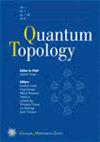广义Haagerup子因子引起的融合范畴的Drinfeld中心
IF 1
2区 数学
Q1 MATHEMATICS
引用次数: 4
摘要
我们考虑广义haagup范畴,使得$1 \oplus X$对于每一个不可逆的简单物体$X$都承认一个$Q$ -系统。我们证明了在这样一个范畴中,二阶可逆对象群的大小最多为4。我们描述了德林菲尔德中心的简单对象,并给出了模数据的部分公式。我们计算了几个例子的模块化数据的剩余角,并对一般情况进行了推测。我们还考虑了广义Haagerup范畴的几种类型的等变化和去等变化,并描述了它们的Drinfeld中心。特别地,我们计算了在小指数子因子分类中产生的融合类别的一些例子的Drinfeld中心的模数据:Asaeda-Haagerup子因子;$3^{\Z_4} $和$3^{\Z_2 \times \Z_2} $子因子;$2D2$子因子;还有$4442$子因子。结果提示了几个新的二次类无限族的可能性。在随附的论文\cite{GI19_2}中,描述和概括了与这些族相关的模数据对度量群。本文章由计算机程序翻译,如有差异,请以英文原文为准。
Drinfeld centers of fusion categories arising from generalized Haagerup subfactors
We consider generalized Haagerup categories such that $1 \oplus X$ admits a $Q$-system for every non-invertible simple object $X$. We show that in such a category, the group of order two invertible objects has size at most four. We describe the simple objects of the Drinfeld center and give partial formulas for the modular data. We compute the remaining corner of the modular data for several examples and make conjectures about the general case. We also consider several types of equivariantizations and de-equivariantizations of generalized Haagerup categories and describe their Drinfeld centers.
In particular, we compute the modular data for the Drinfeld centers of a number of examples of fusion categories arising in the classification of small-index subfactors: the Asaeda-Haagerup subfactor; the $3^{\Z_4} $ and $3^{\Z_2 \times \Z_2} $ subfactors; the $2D2$ subfactor; and the $4442$ subfactor.
The results suggest the possibility of several new infinite families of quadratic categories. A description and generalization of the modular data associated to these families in terms of pairs of metric groups is taken up in the accompanying paper \cite{GI19_2}.
求助全文
通过发布文献求助,成功后即可免费获取论文全文。
去求助
来源期刊

Quantum Topology
Mathematics-Geometry and Topology
CiteScore
1.80
自引率
9.10%
发文量
8
期刊介绍:
Quantum Topology is a peer reviewed journal dedicated to publishing original research articles, short communications, and surveys in quantum topology and related areas of mathematics. Topics covered include in particular:
Low-dimensional Topology
Knot Theory
Jones Polynomial and Khovanov Homology
Topological Quantum Field Theory
Quantum Groups and Hopf Algebras
Mapping Class Groups and Teichmüller space
Categorification
Braid Groups and Braided Categories
Fusion Categories
Subfactors and Planar Algebras
Contact and Symplectic Topology
Topological Methods in Physics.
 求助内容:
求助内容: 应助结果提醒方式:
应助结果提醒方式:


